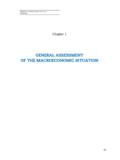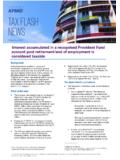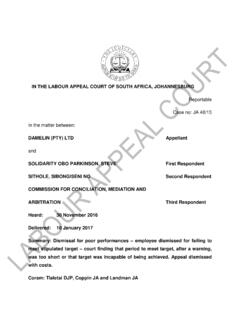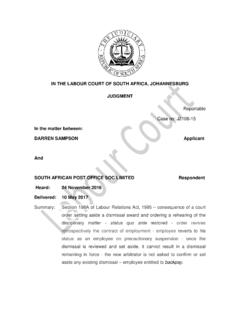Transcription of November 2017 How’s Life in New Zealand? - OECD
1 1 November 2017 How s life in New zealand ? On average, New zealand performs well across the different well-being indicators and dimensions relative to other OECD countries. It has higher employment and lower long-term unemployment than the OECD average, and benefits from lower-than-average levels of labour market insecurity and job strain. Reported social support is also one of the highest in the OECD. While New zealand s environmental quality is high, its performance is mixed in terms of personal security and housing conditions. Although the homicide rate is low, only 65% of people in New zealand say they feel safe walking alone at night, compared to an OECD average of 69%. While the average number of rooms per person in New zealand s homes is among the highest in the OECD, housing affordability is one of the worst. At 82 years, life expectancy at birth is 2 years above the OECD average.
2 A high share of New Zealanders also report good levels of perceived health, although these data are not directly comparable with those of the other OECD countries, due to a difference in the reporting scale. New zealand s average level of current well-being: Comparative strengths and weaknesses Note: This chart shows New zealand s relative strengths and weaknesses in well-being when compared with other OECD countries. For both positive and negative indicators (such as homicides, marked with an * ), longer bars always indicate better outcomes ( higher well-being), whereas shorter bars always indicate worse outcomes ( lower well-being). If data are missing for any given indicator, the relevant segment of the circle is shaded in white. Additional information, including the data used in this country note, can be found at: 2 Change in New zealand 's average well-being over the past 10 years Dimension Description Change Income and wealth Household net adjusted disposable income has increased over the past decade.
3 After rising sharply from 2005 to 2007, growth stalled in 2008, resuming in recent years and peaking in 2013. Jobs and earnings In 2015, the employment rate was very close to its 2005 level, having fallen from 2006 to 2010 and gradually recovered in more recent years. Real earnings in New zealand are 14% higher than a decade ago. Other job indicators have worsened in the last 10 years: labour market insecurity remains relatively high compared to 2005, and the incidence of job strain has risen by almost 7 percentage points. Housing conditions The number of rooms per person has remained relatively stable since 2005, and above the OECD average. Housing affordability has meanwhile worsened slightly in the past decade, with the proportion of income spent on housing costs increasing from in 2005 to in 2014. Work- life balance The share of employees working 50 hours or more per week fell by 2 percentage points from 2005 to 2015 in New zealand , steeper than the fall recorded for the OECD on average over the same period.
4 Health status life expectancy at birth has improved by roughly 2 years since 2005, in line with the OECD average increase. Self-reported health has remained relatively stable from 2007 to 2016. Education and skills The share of adults having completed upper secondary education increased by percentage points from 2014 to 2016 (comparable data are not available prior to 2014). Social connections The share of people who have relatives or friends whom they can count on to help in case of need has remained reasonably stable in the past 10 years. Civic engagement Voter turnout among the population registered to vote fell by percentage points between the 2005 and 2014 general elections. Environmental quality Both satisfaction with local water quality and exposure to air pollution have remained relatively stable in New zealand over the past decade. Personal security The rate of deaths due to assault has fallen by almost one-quarter compared to 2005.
5 The proportion of people who feel safe when walking alone at night has increased gradually, from 61% in 2005-2007 to 65% in 2014-16. Subjective well-being life satisfaction in New zealand has remained broadly stable and at relatively high levels over the past decade. Note: For each indicator in every dimension: refers to an improvement; indicates little or no change; and signals deterioration. This is based on a comparison of the starting year (2005 in most cases) and the latest available year (usually 2015 or 2016). The order of the arrows shown in column three corresponds to that of the indicators mentioned in column two. 3 New zealand s resources and risks for future well-being: Illustrative indicators Natural capital Human capital Indicator Tier Change Indicator Tier Change Greenhouse gas emissions from domestic production 2005-2015 Young adult educational attainment 2014-2016 CO2 emissions from domestic consumption 2001-2011 Educational expectancy.
6 2015 Exposure to air pollution 2005-2013 Cognitive skills at age 15 .. 2015 Forest area 2005-2014 Adult skills .. 2011/2012 Renewable freshwater resources .. Long-term annual avg Long-term unemployment 2005-2015 Freshwater abstractions .. 2010 life expectancy at birth 2005-2015 No data available on threatened species. Smoking prevalence 2006-2015 Obesity prevalence 2007-2016 Economic capital Social capital Indicator Tier Change Indicator Tier Change Gross fixed capital formation 2005-2015 Trust in others .. 2013 Household net wealth .. 2015 Trust in the police .. 2013 Investment in R&D 2005-2015 Trust in the national government 2005-2016 No data available on produced fixed assets, financial net worth of the total economy, intellectual property assets, household debt, financial net worth of government and banking sector leverage.
7 Voter turnout 2005-2014 Government stakeholder engagement .. 2014 Volunteering through organisations .. 2011/2012 Improving over time Top-performing OECD tier, latest available year Worsening over time Middle-performing OECD tier, latest available year No change Bottom-performing OECD tier, latest available year .. No data available 4 HOW LARGE ARE WELL-BEING INEQUALITIES IN NEW zealand ? New zealand has mixed outcomes in terms of vertical inequalities. For instance, although the distribution of earnings is relatively equal compared to most OECD countries, it isn t for cognitive skills or life expectancy. Across OECD countries, women typically fare worse than men on earnings, low pay and employment. Women in New zealand are at a comparatively large disadvantage on outcomes such as feelings of safety, educational attainment and unemployment.
8 However, they fare better than women in the OECD on average in terms of the divides on low pay, work- life balance, time spent socialising, voter turnout, and life satisfaction. In all OECD countries, young people are at a disadvantage on the job market, compared to middle-aged adults. In New zealand , the young are almost 4 times more likely to be unemployed, relative to the middle-aged, one of the highest gaps in the OECD area. However, the age-related gap in employment is narrower than for the OECD on average. In well-being dimensions where young adults are sometimes better off ( educational attainment and skills, social support, feelings of safety), young people in New zealand have fewer advantages than in the OECD on average. People with a tertiary education tend to fare better than those without across a range of well-being outcomes.
9 In New zealand , this education-related gap is often comparatively small with the exception of unemployment, where it is one of the largest in the OECD. In addition, although tertiary-educated people are more likely to work long hours in most OECD countries, the advantage for the secondary-educated in New zealand is smaller than in the OECD on average. Regarding deprivations, New zealand falls the top third ( least deprived) OECD countries in 13 out of 18 indicators. The poorer outcomes include comparatively high asset poverty ( ), the high share of people with less than a secondary level of educational attainment ( ) and that of people who feel unsafe at night (32%). What is inequality and how is it measured? Measuring inequality means trying to describe how unevenly distributed outcomes are in society. How s life ? 2017 adopts several different approaches: - Measures of vertical inequalities address how unequally outcomes are spread across all people in society for example, by looking at the size of the gap between people at the bottom of the distribution and people at the top - Measures of horizontal inequalities focus on the gap between population groups defined by specific characteristics (such as men and women, young and old, people with higher and lower levels of education).
10 - Measures of deprivation report the share of people who live below a certain level of well-being (such as those who face income poverty or live in an overcrowded household). 5 Poverty rateEmployment rateUnemployment rateOver-qualificationIn-work povertyEducational attainmentPISA scoreHaving a say ingovernmentTop thirdMiddle thirdBottom thirdNew ZealandHOW S life FOR MIGRANTS IN NEW zealand ? Migrants (defined as people living in a different country from the one in which they were born) represent an important share of the population in most OECD countries. Capturing information about their well-being is critical for gaining a fuller picture of how life is going, and whether it is going equally well for all members of society. Who are the migrants in New zealand and OECD? One in four people living in New zealand (25%) were born elsewhere, far above the OECD average (13%), and 52% of them are women (51% for the OECD average).


















